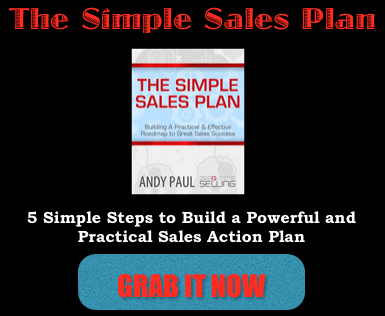Andy Paul's Blog, page 107
February 19, 2013
Are You Managing Sales By Anecdote?

Why are you just guessing?
I was talking to Dennis, a client, last week.
“We want to work on reducing the length of our sales cycle.”
“What is the length of your sales cycle now?”
“12-18 months.”
“You’re sure?”
“Absolutely.” Dennis was emphatic on this point.
“So, which one is it? 12 months? Or 18 months?”
“Umm…”
Umm, indeed. There is a non-trivial difference between the two. It makes a crucial difference in terms of evaluating sales productivity and analyzing the use of your available inventory of sales time.
Like too many sales teams, Dennis and his managers make important decisions about how to structure their sales process, how they allocate management attention and sales resources, and how well they serve their prospects and customers based on assumptions that are built on hearsay and anecdote.
In my experience I have seen that sales managers too often rely on those few gross quantifiable measures of sales performance that provide precious little insight into the effectiveness of the underlying sales processes: sales rep performance against quota, revenues by product, size of the pipeline. Everything else is largely guesswork.
I asked Dennis:
“What percentage of your sales leads are followed up by your sales team?”
“All of them? Honestly, I don’t know.”
“How long does it take distribute sales leads for follow-up?”
“I’m not sure. A couple of days, I think.”
Before you undertake changes to your sales processes, it is imperative to ask yourself: What do you really know about your sales processes? And what data do you have about their effectiveness? What hard facts, not assumptions or anecdotes, do you actually possess about how your sales processes function?
How many sales hours did your sales reps spend on each deal they worked?
Did the sales hours invested correlate to your win ratio?
Did the sales hours spent correlate to the size of the order?
How many sales support hours were consumed on each deal?
Do the number of sales support hours vary by salesperson?
And so on.
As important as the data on the deals you win is to have hard data about the deals you lost. The typical lost sales analysis is consumed with answering the question “why.” It is also crucial to understand the facts about lost sales. How much sales time was invested in lost sales opportunities?
It is critical to stay on top of your key sales metrics. Just make sure that they are actual measures and not estimates, assumptions or folklore. Metrics have no meaningful utility if they are not factual and accurate. The beauty of technology is that everyone has access to tools that can track your sales data.
If you’re ready to move beyond anecdotes, start by measuring one hard number that measures a process that is directly relevant to getting an order. Don’t guess. Then experiment with the process. Make changes to improve it and measure the outcome to ensure it has the desired result. Then keep measuring and refining.
 Andy Paul is author of the award-winning book, Zero-Time Selling: 10 Essential Steps to Accelerate Every Company’s Sales. A sought-after speaker and business coach, Andy conducts workshops and consults with sales teams of all sizes to teach them how to use responsiveness, speed and intelligent processes to increase sales. Enjoy what you just read? Sign up for our regular digest of valuable Zero-Time Selling sales tips and strategies, “Selling with Maximum Impact.”
Andy Paul is author of the award-winning book, Zero-Time Selling: 10 Essential Steps to Accelerate Every Company’s Sales. A sought-after speaker and business coach, Andy conducts workshops and consults with sales teams of all sizes to teach them how to use responsiveness, speed and intelligent processes to increase sales. Enjoy what you just read? Sign up for our regular digest of valuable Zero-Time Selling sales tips and strategies, “Selling with Maximum Impact.”
© Andy Paul 2013
The post Are You Managing Sales By Anecdote? appeared first on Zero-Time Selling with Andy Paul.

February 17, 2013
Selling 9 to 5 Just Doesn’t Cut It

What Separates The Best From The Rest?
I am often asked about the attributes that comprise the top sale professional. Here is one that I believe is vital to consistent sales success: The best salespeople I know are continuously strategizing about the opportunities they’re pursuing. They are thinking 24/7 of new ways that they can help their customers make an informed purchase decision. They know they can’t afford to mentally “lock away” their prospects when they leave work at the end of the day.
The most successful salespeople I have worked with possess a complete command of all the details of every sales opportunity they currently are working on. They let them continuously tumble around in the back of their minds, ruminating about possible winning strategies and tactics. They don’t have an “off” switch.
As I wrote about in my article titled “The Uncertainty Principle in Selling” the process of selling to your prospect invariably changes their requirements and decision criteria moving forward. The very process of discovery, of helping the prospect define their requirements, and providing the data and information in response to their questions, forces them to re-assess their needs and what the criteria will be that they use in evaluating sellers and making an informed purchase decision.
Salespeople who sell from 9 to 5 and mentally lock away their customers at the end of the business day invariably fail to take notice of these changes. They choose to believe that sales and buying cycles are static processes that proceed in a linear fashion from Point A to Point B and they lose out to the salespeople that recognize the vagaries and flexibility of those cycles.
A client of mine had a salesperson named Ty. Ty was a veteran salesman and typically developed a good rapport with his customers. But he didn’t store any of the details of his sales opportunities in his head. He was an avid user of the company’s CRM system though, into which he entered every bit of data he needed about his customers. But, because he knew that all his customer information was available from the CRM system it disappeared from his mind the moment he hit the Enter key. Poof! When asked by his manager to do a review of his sales opportunities at a sales meeting, Ty couldn’t recall details about his accounts without referring to the CRM system. And he wondered why he was always in reactive mode with his prospects and customers. Ty thought sales was an open-book test. Unfortunately sales, and life, don’t work that way.
It is a temptation for today’s sales professional, with all the technology they have at their fingertips to assume that they can always stay on top of the deals they are working by referring back to the data in their CRM system or their notes. But what sets the great salespeople apart are that they are always working their deals, constantly thinking of new ways to provide value to their prospects in order to win more orders in less time.

 Andy Paul is author of the award-winning book, Zero-Time Selling: 10 Essential Steps to Accelerate Every Company’s Sales. A sought-after speaker and business coach, Andy conducts workshops and consults with sales teams of all sizes to teach them how to use responsiveness, speed and intelligent processes to increase sales. Enjoy what you just read? Sign up for our regular digest of valuable Zero-Time Selling sales tips and strategies, “Selling with Maximum Impact.”
Andy Paul is author of the award-winning book, Zero-Time Selling: 10 Essential Steps to Accelerate Every Company’s Sales. A sought-after speaker and business coach, Andy conducts workshops and consults with sales teams of all sizes to teach them how to use responsiveness, speed and intelligent processes to increase sales. Enjoy what you just read? Sign up for our regular digest of valuable Zero-Time Selling sales tips and strategies, “Selling with Maximum Impact.”
© Andy Paul 2013
The post Selling 9 to 5 Just Doesn’t Cut It appeared first on Zero-Time Selling with Andy Paul.

February 14, 2013
Are Your Stories Worth Repeating?

Take Advantage of the “Telephone Effect”
A lot has been recently written about the power of stories in selling. The power of stories to communicate context and value is undeniable, if they are used correctly.
The effective use of stories requires you to remember that the exclusive audience for your story is not the person to whom you initially tell the story. Even if that person is the final decision maker. You have to make your stories memorable and repeatable. Because they need to be retold throughout the prospect’s company to take advantage of the “telephone effect.”
What’s the “telephone effect?” When you were a kid, do you remember playing the game called “telephone?”
The rules were pretty simple. You and your friends sat on the floor in a big circle. One person started the game by whispering a short piece of gossip or fiction, usually something slanderous about one of the kids in the circle, into the ear of the kid sitting to their left. That kid in turn whispered what they had heard into the ear of the kid sitting to their left. And on and around the story traveled from ear to ear until the last kid to have heard the “telephone message” stood up and repeated what they thought they heard. What started out as “Jack and Jill went up the hill to fetch a pail of water” invariably turned into “Jill hijacked a pill truck with Gayle, her daughter.”
This same dynamic is in play with the stories and the presentations you tell your prospects. You need to harness the power of the “telephone” dynamic to your sales advantage. Here’s how to do it and it all starts with the stories you tell. (If you haven’t read my article on sales stories, What’s Your Story, click here to do that first.)
Your stories have to be memorable so your prospect wants to repeat them internally. Your internal sales advocates have to be able to communicate the value of your product, service and company to multiple audiences throughout their organization. What you hope is that those people will in turn re-tell the story to other internal audiences. When that happens your value, features, benefits and reputation inevitably are amplified and solidified through the retelling. This is the “telephone effect” kicking in and working to your advantage. The more memorable your story, the more often it will be re-told.
In order for the prospect to effectively re-tell them, your stories have be easy to remember. The key to making your stories repeatable is to make certain they follow a common structure that quickly answers four simple questions in logical order:
Why did the customer call your company to help solve their problem?
What problem(s) were they trying to solve?
Why did they select your company and product/service?
What value did the customer receive from your product/service?
Answer these four questions and your stories will be concise and flow in a logical fashion that the prospect can remember. Practice telling your stories to your colleagues. You want to be certain that they are absolutely clear about the value you provide.
Stories that are memorable and repeatable will accelerate your ability to Sell with Maximum Impact in the Least Time and compress buying cycles.
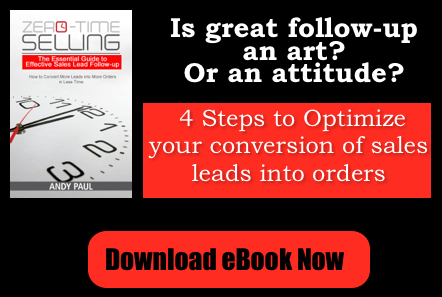
 Andy Paul is author of the award-winning book, Zero-Time Selling: 10 Essential Steps to Accelerate Every Company’s Sales. A sought-after speaker and business coach, Andy conducts workshops and consults with sales teams of all sizes to teach them how to use responsiveness, speed and intelligent processes to increase sales. Enjoy what you just read? Sign up for our regular digest of valuable Zero-Time Selling sales tips and strategies, “Selling with Maximum Impact.”
Andy Paul is author of the award-winning book, Zero-Time Selling: 10 Essential Steps to Accelerate Every Company’s Sales. A sought-after speaker and business coach, Andy conducts workshops and consults with sales teams of all sizes to teach them how to use responsiveness, speed and intelligent processes to increase sales. Enjoy what you just read? Sign up for our regular digest of valuable Zero-Time Selling sales tips and strategies, “Selling with Maximum Impact.”
© Andy Paul 2013
The post Are Your Stories Worth Repeating? appeared first on Zero-Time Selling with Andy Paul.

February 12, 2013
What Do You Need to Unlearn This Year?
 Selling is a learning-based profession. The key to mastering your craft as a sales professional is to constantly learn new perspectives on selling and master new sales skills. It is important to take the time to inventory your current strengths and weaknesses and assess what you need to learn to help you develop more prospects and close more orders.
Selling is a learning-based profession. The key to mastering your craft as a sales professional is to constantly learn new perspectives on selling and master new sales skills. It is important to take the time to inventory your current strengths and weaknesses and assess what you need to learn to help you develop more prospects and close more orders.
At the same time it is important to have an open mind about the unproductive sales beliefs and practices that you should eliminate, or “unlearn,” that waste your limited selling time and decrease your upside sales potential. You have to perform an honest self-assessment and ask yourself: What do I need to unlearn this year?
Here are a few examples of counter-productive sales beliefs, behaviors and practices that I encounter in my work with clients as a sales coach that need to be unlearned:
1. Marketing-generated sales leads are worthless. It is invariably a sign of trouble when salespeople say that the only good sales lead is the one they developed themself. Once upon a time there may have been some validity to this point of view. But not now. Potential prospects have the information at their disposal to substantially pre-educate themselves about products and services before they ever reach out to engage with a seller. When they initiate contact they are well into their buying process and need to be taken seriously.
2. There is always time to respond to leads and customers. There isn’t. The operating assumption for you, the salesperson, has to be that prospects are making decisions based, at least in part, on how effectively you utilize their time. Waiting for you constitutes a bad use of their time. If the prospect invests time in you, and you make good use of that time, they will reward you with additional time in order to continue selling. Your prospects have plenty of options. Waste their time at your peril.
3. Customer relationships are built on interpersonal skills. This needs to be unlearned in a hurry. At the end of the day relationships with prospects and customers are based on Needs and Deeds (link to post). You can be as personable and sincere as the day is long but if you aren’t meeting the prospect’s needs, you won’t develop a productive, long-term relationship with them. The best salesperson I’ve seen in action in the past decade was pathologically shy. But he knew his products and understood his customers and was able to guide them through their buying cycle faster than his competitors.
4. It is all about the product. It isn’t. In most instances, the customer could care less about your particular product. What they care about is whether you, and your product or service, can provide the optimal solution to their problem. Whether the solution they buy is your product or a product from the World-Wide Widget Company, doesn’t make a difference to them.
What do you have to unlearn this year?
 Andy Paul is author of the award-winning book, Zero-Time Selling: 10 Essential Steps to Accelerate Every Company’s Sales. A sought-after speaker and business coach, Andy conducts workshops and consults with sales teams of all sizes to teach them how to use responsiveness, speed and intelligent processes to increase sales. Enjoy what you just read? Sign up for our regular digest of valuable Zero-Time Selling sales tips and strategies, “Selling with Maximum Impact.”
Andy Paul is author of the award-winning book, Zero-Time Selling: 10 Essential Steps to Accelerate Every Company’s Sales. A sought-after speaker and business coach, Andy conducts workshops and consults with sales teams of all sizes to teach them how to use responsiveness, speed and intelligent processes to increase sales. Enjoy what you just read? Sign up for our regular digest of valuable Zero-Time Selling sales tips and strategies, “Selling with Maximum Impact.”
© Andy Paul 2013
The post What Do You Need to Unlearn This Year? appeared first on Zero-Time Selling with Andy Paul.

February 11, 2013
Are You Giving Your Prospects A Clear Choice?
 In his book, The Paradox of Choice, Barry Schwartz, a professor at Swarthmore College, put forth the thesis that one of the serious downside consequences of our modern economy is that businesses and consumers have too many choices. In recent years there has been a huge increase in the number of offerings for nearly every category of product and service. As a result, buyers have become paralyzed by the mere act of having to choose.
In his book, The Paradox of Choice, Barry Schwartz, a professor at Swarthmore College, put forth the thesis that one of the serious downside consequences of our modern economy is that businesses and consumers have too many choices. In recent years there has been a huge increase in the number of offerings for nearly every category of product and service. As a result, buyers have become paralyzed by the mere act of having to choose.
Schwartz also writes that he believes that buyers that have had to choose from among too many alternatives are also typically less happy with the choice they made and more likely to experience some form of buyers remorse.
What does this mean for salespeople? I believe the paradox Schwartz describes speaks to a shortcoming in most of us who sell. When the product or service we are selling is perceived by our prospects to be largely undifferentiated from those of our competitors, it means that we haven’t given them a clear reason to purchase our offering. As a seller, it is our responsibility to reduce the number of choices for the prospect by standing apart from our competitors, making it easier and quicker for them to make a decision. When products and services are perceived by customers to be very similar the basis for their decision turns to the intangibles.
In this environment the task for us, the seller, is to differentiate ourself and present a clear and compelling choice to the prospect based on how we sell our product or service. Are we being responsive in Zero-Time to the customer’s request for information they need to make an informed purchase decision with the least investment of their time possible? Are we Selling with Maximum Impact in the Least Time to provide substantive value on each customer interaction? Are we creating the positive First Perception that provides a first mover sales advantage in building trust, creating credibility and differentiating us from the competitors? Do these things and we will create substantive value for the prospect by standing out from the crowd, giving them the opportunity to make a rare, clear-cut choice.
I don’t believe the problem is that buyers today have too many choices. I believe the issue confronting customers today is that the many choices they have are largely undifferentiated. If the alternatives from which a customer has to choose are perceived to be virtually identical then it is natural that they would be curious about whether they could make the “best” decision. Buyers remorse is a reaction on the part of the customer that their decision to purchase from us was not an affirmative choice to buy the absolute best solution but of choosing the least bad of the alternatives. As a seller, we absolutely have it in our power to ensure that our customers always feels like they made the best, and only, decision they could have made.
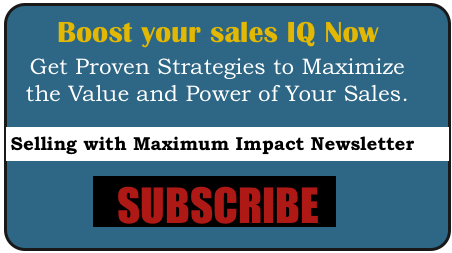
 Andy Paul is author of the award-winning book, Zero-Time Selling: 10 Essential Steps to Accelerate Every Company’s Sales. A sought-after speaker and business coach, Andy conducts workshops and consults with sales teams of all sizes to teach them how to use responsiveness, speed and intelligent processes to increase sales.
Andy Paul is author of the award-winning book, Zero-Time Selling: 10 Essential Steps to Accelerate Every Company’s Sales. A sought-after speaker and business coach, Andy conducts workshops and consults with sales teams of all sizes to teach them how to use responsiveness, speed and intelligent processes to increase sales.
© Andy Paul 2013
The post Are You Giving Your Prospects A Clear Choice? appeared first on Zero-Time Selling with Andy Paul.

January 13, 2013
Is Yours A Vicious Sales Cycle? Or A Virtuous Sales Cycle?
By Andy Paul

Which One Are You In?
Most everyone is familiar with the concept of a vicious cycle, or vicious circle (i.e., a repeating sequence of connected events in which each cycle reinforces the previous one, in this case, negatively).
In sales, a Vicious Sales Cycle stems from bad sales practices that lead to poor results combined with an inability or unwillingness to change, which leads in turn to a never-ending, self-reinforcing cycle of unacceptable sales performance. Unfortunately too many sales professionals operate within a Vicious Sales Cycle.
What are some key behaviors that open the door to a vicious sales cycle?
1. Lack of consistently applied sales processes. Success in sales is based on a foundation of well-defined, documented sales processes (and associated metrics) that establish clear expectations for how selling should occur in your organization.
2. Lack of responsiveness. Today’s customer is substantially pre-educated about your product or service before they ever engage with your sales team. By definition, when they do contact you for the first time their need for information in order to make a decision is urgent.
3. Lack of urgency. See #2 above. The timeframe for every sales action should be immediate. It’s what customers expect. Anything less is the start of a slippery slope.
4. Lack of product knowledge and business acumen. Customers rely on you to provide the necessary content and context they require to make a fully informed purchase decision. Customers will be reluctant to invest their time to build relationships with sellers who can’t provide value.
Your goal should be to build a Virtuous Sales Cycle. A virtuous cycle is defined as a “Self-propagating advantageous situation in which a successful solution leads to more of a desired result or another success which generates still more desired results or successes in a chain.”
A Virtuous Sales Cycle is what happens when best sales practices are consistently applied to produce above-average results, which in turn create a chain of positive results that feed off of each other to generate even better performance.
Therefore, the aim of every salesperson should be to convert their sales efforts into Virtuous Sales Cycles rather than the all-too-typical Vicious Sales Cycle in which unresponsive, time-wasting sales behaviors spiral downwards into a never-ending series of poor performance.
What are a few of the behaviors you should use to create and perpetuate a Virtuous Sales Cycle?
1. Sell with Maximum Impact in the Least Time. Selling with Maximum Impact in the Least Time means that every interaction with a customer must be pre-planned to achieve the maximum impact and provide the maximum value for the customer with the least investment of their time possible.
2. Be absolutely responsive to the customer in Zero-Time. Because the timeframe for every sales action is immediate anything that you put off, any customer interaction that you defer until later, is less likely to ever occur. In my training courses I teach that “later” lives on the same street as “never.”
3. Continually fine-tune your sales processes. Nothing stays the same. Products change. Customers change. Technology changes. How you sell your product, and the metrics used to measure the effectiveness of your processes, have to evolve to keep pace with these changes.
Let’s put this in context and see how you can use these to initiate your Virtuous Sales Cycle. What happens when you consistently sell with Maximum Impact and enable your customers to make informed purchase decisions with a smaller investment of their time? By virtue of selling more effectively you will naturally compress the customers’ buying cycle. Compressing their buying cycle will not only win you more orders it will also create more selling time for you to sell to additional prospects. (Reduce your prospects’ buying cycle by 5% then you will suddenly have 5% more sales time. This could be equal to an extra 13 selling days per year. How many more orders could you win with that extra time?) If you sell to these additional prospects in the same effective manner then this process of positive sales outcomes becomes self-propagating. Success begets success and you have kick-started your Virtuous Sales Cycle.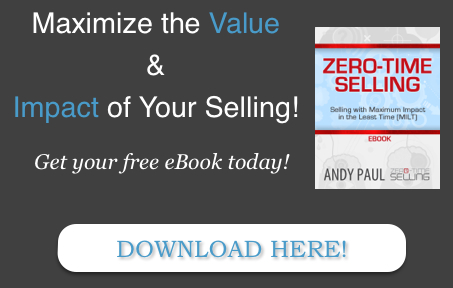
 Andy Paul is author of the award-winning book, Zero-Time Selling: 10 Essential Steps to Accelerate Every Company’s Sales. A sought-after speaker and business coach, Andy conducts workshops and consults with sales teams of all sizes to teach them how to use responsiveness, speed and intelligent processes to increase sales. Enjoy what you just read?Sign up for our regular digest of valuable Zero-Time Selling sales tips and strategies, “Selling with Maximum Impact.”
Andy Paul is author of the award-winning book, Zero-Time Selling: 10 Essential Steps to Accelerate Every Company’s Sales. A sought-after speaker and business coach, Andy conducts workshops and consults with sales teams of all sizes to teach them how to use responsiveness, speed and intelligent processes to increase sales. Enjoy what you just read?Sign up for our regular digest of valuable Zero-Time Selling sales tips and strategies, “Selling with Maximum Impact.”
© Andy Paul 2013
The post Is Yours A Vicious Sales Cycle? Or A Virtuous Sales Cycle? appeared first on Zero-Time Selling with Andy Paul.

December 27, 2012
When Deals Slow Down: Are You The Solution or the Problem?
By Andy Paul
 When D
eals Slow Down, How Do You Fix It?
When D
eals Slow Down, How Do You Fix It?
I attended a conference this year where it was suggested that just as customers have the ability to use social media and other forums to publicly rate their suppliers so too should sellers have a forum to rate their customers. The suggestion was offered in a somewhat humorous vein but there was an air of seriousness behind it. One of the main rating criteria for the customer that was put forth was whether the customer was a slow buyer.
Listening to this I thought more about this common sales perception that when a deal that you’re working on slows down, and loses momentum, that it is invariably the fault of the prospect. Undoubtedly there are valid reasons why a prospect will slow down the pace of a buying process. Organizational upheaval, changes in the economy and stock market, are examples of the changes that can impact a prospect’s buying process.
However, more often than not, the party responsible for a deal that stalls is the person you see when you look in the mirror in the morning. That’s right. You. Why?
First, let’s look at the buying process. There are several different perspectives on how many steps are in a customer’s buying process. Some say 4 (AIDA). Others think 5. I happen to believe that there are 6 steps in a customer’s buying process. Irrespective of the number of steps there are in your prospects’ buying process there is one hard and fast rule. The prospect will not move from one step of their buying process to the next until their information requirements for the current step are completely fulfilled.
Second, the prospect’s buying process is not monolithic. It is not a giant buying process that includes all the vendors or alternative solutions the prospect is considering. The prospect has a buying process for each solution/vendor they are evaluating.
If you aren’t providing the prospect the information they need to move through their buying process and make a fully informed purchase decision in the least time possible then your dealings with them are going to come to a halt. But that doesn’t mean that they are not continuing their evaluations of their alternatives. The beat goes on. Just without you.
A study by DemandGen and Genius.com in 2010 titled “Inside the Mind of the B2B Buyer” contained the finding that 95% of B2B customers selected the seller who provided them with ample content to navigate each step of their buying process. The real lesson derives from the inverse of their finding. Namely, that if you aren’t giving the customer the information they need to progress from one step of their buying process to the next, then you aren’t going to win their business.
Your prospect’s resources are stretched thin. Just like yours. Time is at a premium and they want to make the most informed purchase decision in the least time possible. No customer ever sets out to buy a product and service by saying “I want to take as long as possible to make this decision.” Prospects don’t want to spend 6 months to make a decision that they could make in 2 months if they received the information they required to make that informed purchase decision. Similarly they don’t set out to spend a month to make a purchase decision that they could make in one day if the seller(s) provided them with the data they needed.
If you have a deal that suddenly slows down, don’t point fingers at your customer. Do some quick investigative work. Where is the prospect in their buying process? What specific information about your product or service does the prospect need to move forward to the next step of their buying process that you haven’t supplied? If you don’t know the answer to this question, don’t guess. Call the customer and ask. Meet with the customer and do a recap of where they stand in their buying process with you. Then map out a schedule with the customer on the information and data that they will need from you to reach their decision point and agree on the timeframes when you are going to provide it. This will represent the minimum you need to do to get back into the game and stay under consideration.
When the deal you’re working on slows down, are you part of the problem? Or part of the solution?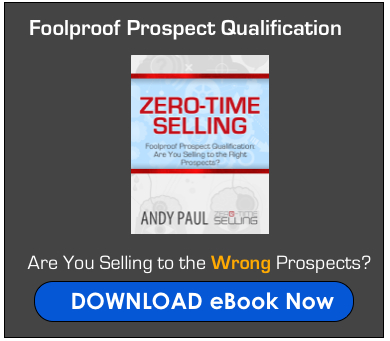
 Andy Paul is author of the award-winning book, Zero-Time Selling: 10 Essential Steps to Accelerate Every Company’s Sales. A sought-after speaker and business coach, Andy conducts workshops and consults with sales teams of all sizes to teach them how to use responsiveness, speed and intelligent processes to increase sales. Enjoy what you just read? Sign up for our regular digest of valuable Zero-Time Selling sales tips and strategies, “Selling with Maximum Impact.”
Andy Paul is author of the award-winning book, Zero-Time Selling: 10 Essential Steps to Accelerate Every Company’s Sales. A sought-after speaker and business coach, Andy conducts workshops and consults with sales teams of all sizes to teach them how to use responsiveness, speed and intelligent processes to increase sales. Enjoy what you just read? Sign up for our regular digest of valuable Zero-Time Selling sales tips and strategies, “Selling with Maximum Impact.”
© Andy Paul 2013
The post When Deals Slow Down: Are You The Solution or the Problem? appeared first on Zero-Time Selling with Andy Paul.

December 20, 2012
Is Follow-up an Art? Or an Attitude?
By Andy Paul
Not that long ago I read a blog posting about the art of the follow-up. I liked the general concept presented by the author, that there are skills we can all learn that will improve the effectiveness of our sales follow-up. It was hard to argue with his premise.
However, I believe that the author put the cart before the horse. While there are skills to be learned that, if regularly practiced, will improve the quality of your follow-up, there is one big caveat that trips up many, if not most, sellers. That catch is that before you can practice the art of the follow-up you actually have to pick up the phone and call the prospect.
I have read studies and statistics about sales follow-up that are uniformly depressing. At the high-end they estimate that 80% of sales leads are never followed up. On the low-end they claim 30% of sales leads are never followed up. (Personally, I think that anything above 0% is a failure of management, but I’ll leave that for another rant. I mean post.) No matter which end of the statistical spectrum you subscribe to, the bottom line is that follow-up suffers more from inattention that ineffectiveness.
To frame this in an even grimmer light, seminal studies, such as the Insidesales.com/MIT Lead Response Management Study, unequivocally demonstrate that it is not enough to simply follow-up. Effectiveness of follow-up is directly tied to how quickly follow-up occurs. The conclusion of the MIT study is stunningly self-evident but its lessons continue to be blithely ignored by the vast majority of sellers. The study demonstrated that the longer you take to follow-up the less likely you are to actually contact the prospect. In short, any interest a prospect has in talking to you quickly diminishes once they have reached out to you.
Therefore, the central issue in effective follow-up is attitudinal. A seller simply has to commit to take action. Quickly. Put aside thoughts of technique until you take an action that would benefit from it.
With clients I like to use the term “equivalence” to describe how they should treat follow-up. Ask yourself this question: how do you want a seller to follow-up with you? If you are interested in a company’s products and you submit an inquiry, what are your expectations for follow-up? You must have some expectation the company would get back to you because you wouldn’t have taken the time to reach out to them otherwise. Apply an equivalent expectation to your own, or your sales team’s, follow-up efforts.
Early on in the process to publish and promote my book I decided that I would accelerate my learning curve by hiring an experienced consultant that could help me bring my book to market with a bang. I attended a number of conferences on book marketing and met with some book marketing experts who are considered by many to be luminaries in their field. I had the book and the budget to hire the right resource. I met first with Luminary #1, who loved the idea of my book and was excited to talk in more depth about how she could help me. We set a time for a follow-up phone call. She never called and never followed up. Luminary #2 was also interested in helping me get my book to market and his follow-up was as non-existent as his counterpart’s. However, he did take my card and was thoughtful enough to stick my name onto about a dozen of his mailing lists that I have had to unsubscribe from.
In follow-up attitude precedes art just like form follows function.
I recently searched online for pricing information on a particular SaaS application that I wanted to use for my business. The vendor offered up only two service options their website: Professional (Individual) and Enterprise. Frustratingly, the company’s website contained no pricing information on either option and no way to purchase the product. I filled in a web form asking for pricing information. Two weeks later I got an email response from a sales manager stating that if I wanted price information I had to set up a phone call with her to go over my requirements. Two weeks. In the meantime, I had purchased an alternative solution.
The art of follow -up is less important than the act of follow-up. Commit to being in the game first and then work on your craft.
© Andy Paul 2013
The post Is Follow-up an Art? Or an Attitude? appeared first on Andy Paul | Strategies to Power Growth.

November 7, 2012
How to Create Value with Each Customer Interaction
By Andy Paul
[image error] Are You Creating Value with Each Customer Interaction?
I read a blog posting recently about what a salesperson could do to increase sales. The title was something catchy like “A Billion and One Tips to Increase Sales.” It was hard to argue with the premise of the post. Everyone in sales can use good advice on increasing sales. It’s the reason I continue to read everything I can about sales. There is always something new to learn.
In this case, this author’s useful quick tips were all about creating more sales activity. He was asking the question ‘What should you do if you have prospects but they aren’t moving forward fast enough?’ and providing answers that were designed to create a flurry of sales activity around prospects to stimulate them to engage and move forward with the seller.
But is selling the same as sales activity? And, if a prospect is not yet fully committed to the buying process, is random sales activity the way to get them engaged?
Nothing is sometimes better than something
I had a salesperson, named Arte, working for me once who had confused activity with selling. He came into my office one day and told me that he had invented his own method of selling that he called SWARM. The acronym stood for Surround With Activity to Regain Momentum. His thought was to envelop his prospects in a constant swarm of sales activities such as of phone calls, visits, emails, voice messages, invitations to webinars and seminars, product demonstrations in the hope that eventually something would stick and the prospect would relent and engage.
How’d that work for Arte? Not so well. But he got high marks for creativity.
Unfortunately, similar to Arte, many salespeople fall into the trap of believing that doing something, anything, with a prospect is better than doing nothing. This happens all the time when the prospect has gone radio silent. There are lots of reasons why this occurs and it is the job of the salesperson to determine the answer and respond appropriately and with content that has value for the prospect. But rarely is the correct response to bombard the prospect with trivial, time-wasting requests and interactions.
Keep in mind the customer’s objective
In a sales situation, or buying situation, it is important to keep in mind that the goal of the customer is to gather the information or data they need to make an informed purchase decision with the least investment of their time possible. This is not to say that customers won’t spend the appropriate time to purchase a product or service. This just means that they don’t want to invest a minute more than they have to.
Create and deliver value each time you talk to your prospects and customers
If you are selling you should only be taking actions with a customer that have a defined purpose, deliver clear value and support the customer’s goal. To that end, instead of unthinkingly reaching out to the customer and demanding some of his or her time with a trivial request, consider the opposite approach: make sure that every interaction you have with a prospect or customer achieves Maximum Impact in the Least Time (MILT) possible. It requires planning and thought to make certain that each time you interact with the prospect or customer you are providing information that will bring them closer to their goal of making an informed decision. But the result is that you will bring value to the customer through your selling. If you want a customer to engage, create value for them by your actions. Wasting their limited time with “sales activities” does the opposite.
Selling has a purpose. It is not the goal of your prospects or customers to spend time with you. In fact, the opposite is true. They want to accomplish their job, which is to buy a product or service, while spending as little time with the salesperson as possible. The winning salesperson will usually be the one who knows how to make that happen.
© Andy Paul 2013
The post How to Create Value with Each Customer Interaction appeared first on Andy Paul | Strategies to Power Growth.

October 26, 2012
3 Examples of How Not to Treat Your Prospects Most Valuable Commodity
Your Enemy is Time. Not Your Prospects.
What is the one valuable commodity that is in short supply for both your prospect and you, the seller? It is time.
If you’ve read my article on The Economics of Attention you know that your prospects are making economic decisions on how to efficiently allocate their limited time, and attention, among the many demands that are placed on it. In this excerpt from my award-winning book, Zero-Time Selling: 10 Essential Steps to Accelerate Every Company’s Sales, I discussed the concept of a Return on Time Invested (ROTI) and its importance in selling:
“A sell/buy transaction is essentially an investment opportunity for both the customer and the seller. For each party to do its job well, both have to invest a certain amount of time (which we all know is money), as well as money. Both the customer and the seller want to maximize their Return on Time Invested (ROTI) in their respective buying and selling cycles. For the buyer this means making an informed decision to purchase a solution that meets their value, budget, and feature requirements with the least investment of time possible. For the seller this means supporting the buyer with the information they need to make the optimum informed purchase decision in the shortest period of time possible.”
If you make good use of the time a prospect invests in you as a seller; if the prospects realizes value and a good return on the time they invest in you, then you will be rewarded with more time, and have the inside track to win the order.
The concept is so simple and yet it seems that every day I encounter examples of bad sales service that needlessly waste a prospect’s time. At the same time, the sellers appear to be completely clueless about the negative consequences of their actions, and as you will see below, even celebrate their poor sales service. Here are a few quick stories to illustrate the point. If you have your own story please send it to me at andy@zerotimeselling.com.
Story 1: I returned home from a vacation to find that a prolonged drought had driven several million thirsty ants to relocate from my backyard into my kitchen in search of water. They were marching in thick black lines from one end of the white tile floors in my kitchen to the other. I needed help and immediately hopped online to find a local exterminator. The first company listed on the Google search returns, which I’ll call Ant-Away Exterminating, claimed they had an organic, technologically advanced solution for exterminating pests that was safe for people and pets. Perfect! Riley and Nico, my golden retriever and exuberant poodle-type mutt, would appreciate that. Plant friendly, pet friendly (unless your pets are insects…), people friendly, environmentally friendly, and absolutely lethal to bugs of all stripes. What more could be better?
Ant-Away published a number for their 24-hour hotline on their website. Twenty-four hours a day. Wow, good service! Help when I needed it. I was ready to buy. I dialed their hotline number which offered up a recording that invited me to leave a message for one of their customer service technicians. Then the exuberant female voice on the recording proudly trumpeted “our company policy: your phone call will be returned within 24 hours. Guaranteed!”
Twenty-four hours. They thought that was fast. But their fast was my slow. I had ants all over my house and I didn’t have 24 hours to wait for them. I needed to take care of the problem now.
Ant-Away had the perfect opportunity to capture my business. But, like a lot of companies, they prized their convenience over being responsive to their customers. And they had the chutzpah to attempt to turn their shortcomings into a virture. Instead, what they communicated to me, and all their other prospective customers, were three negative messages:
1. Your call is not that important to us. In fact, you are not going to talk with a salesperson or customer service rep when you call. In fact, you won’t even speak to a live person at all.
2. The only guarantee we can offer is that we won’t call you back until tomorrow. What’s the rush? We’ve given ourselves 24 hours!
3. We need to have a company policy in place to force someone to call you back at all.
I called the next pest-control company on the search returns.They actually answered their phones with a live operator and set me up with a same-day appointment with their technician. Within a few hours the ants had been persuaded to quench their thirst outdoors.
Story 2: A client was going through a growth spurt and was hiring a lot of people. They were inundated with resumes being submitted online so the CEO, Dennis, decided to invest in a software system to track resumes and applicants. He spent an entire weekend researching the various software options that were available to him and narrowed his options down to three companies. He sent each a detailed email to each firm with his requirements, reinforced the urgency of his situation and asked that he be called ASAP. Two weeks passed before he received the first response from any of the 3 vendors.
The salesperson seemed a little confused when Dennis informed him that he was going to stick with his current system for the time being. Hadn’t Dennis just sent his company an email stating he needed their solution? Dennis said he had but he figured that if it took two weeks just respond to his sales lead how much would he have to invest to go through the whole sales process? He couldn’t wait so he had figured out a way to cope with the volume of resumes they were receiving with his existing manual system. Six months later Dennis invested in a solution to manage and track applicants. None of the three vendors he had originally contacted were given the chance to bid on his business.
Story 3: Recently I needed to purchase a particular software solution for my company. I invested several hours researching the alternatives. I spent more hours setting up accounts to try free trial versions of the applications. Over the course of several weeks I narrowed my choices to one application from a California-based B2B SaaS company that appeared to best fit my needs. I’ll call them AAATech. However, after using their application for a couple of weeks, I still needed some answers to a few specific questions before I could make my final decision. I couldn’t find the necessary information on AAATech’s website. I needed to talk to a salesperson.
I tried to locate a phone number on AAATech’s website so I could call to speak to a salesperson. But they didn’t offer one. In fact, they didn’t publish a single phone number anywhere on their website. That was the first red flag. However, I was undaunted because I had already invested hours of my time and invested a more time to track down an email address for their Sales department. I submitted a list of five very specific questions. Within an hour I received an email response. I was encouraged. Taking an hour to follow-up a lead isn’t what I call great responsiveness but it was certainly better than most companies. I enjoy doing business with like-minded companies. But, then I read the response.
Dear Andy,
Thank you for your interest in AAATech. We are here to help you. Please let me know if you have any questions.
Regards,
Michael
Seriously? I invested the time to pre-educate myself about AAATech’s products. I invested the time to write a detailed email about my requirements and send it to sales@AAATech.com. And, in return for my investment of time and effort, I was thrown into a lead nurturing queue and sent a general auto-responder email that was somehow supposed to lure me into their sales funnel. For me it was a negative return on the time I had invested.
I bought from another company. I am sure that many other prospects have also.
© Andy Paul 2013
The post 3 Examples of How Not to Treat Your Prospects Most Valuable Commodity appeared first on Andy Paul | Strategies to Power Growth.

Andy Paul's Blog
- Andy Paul's profile
- 4 followers


